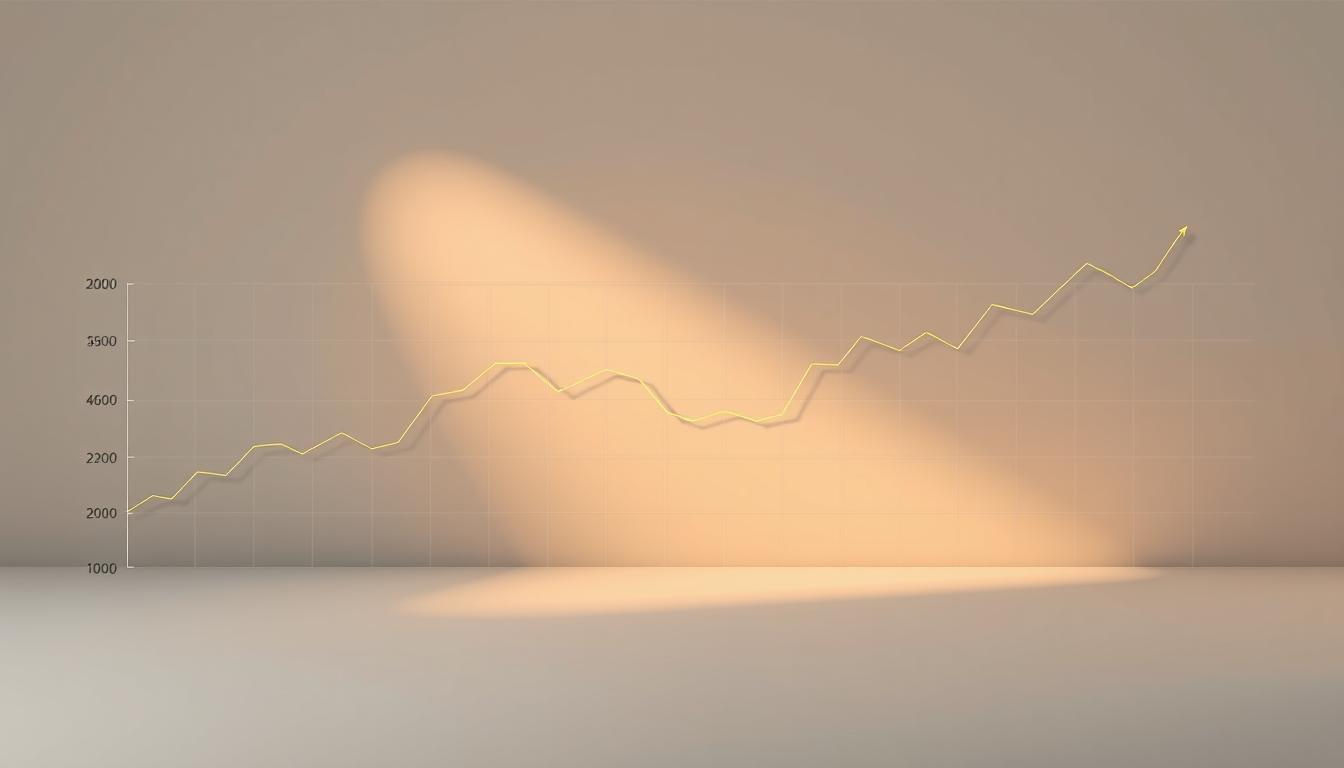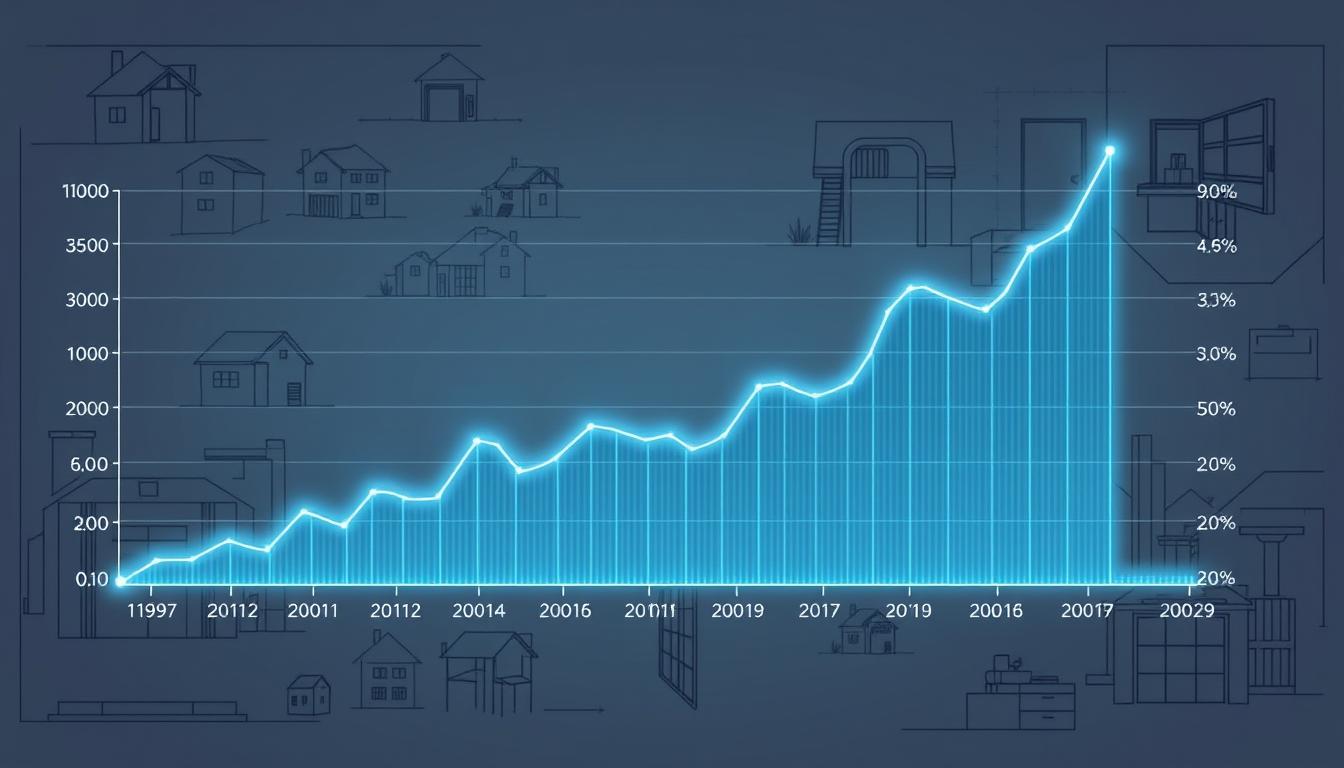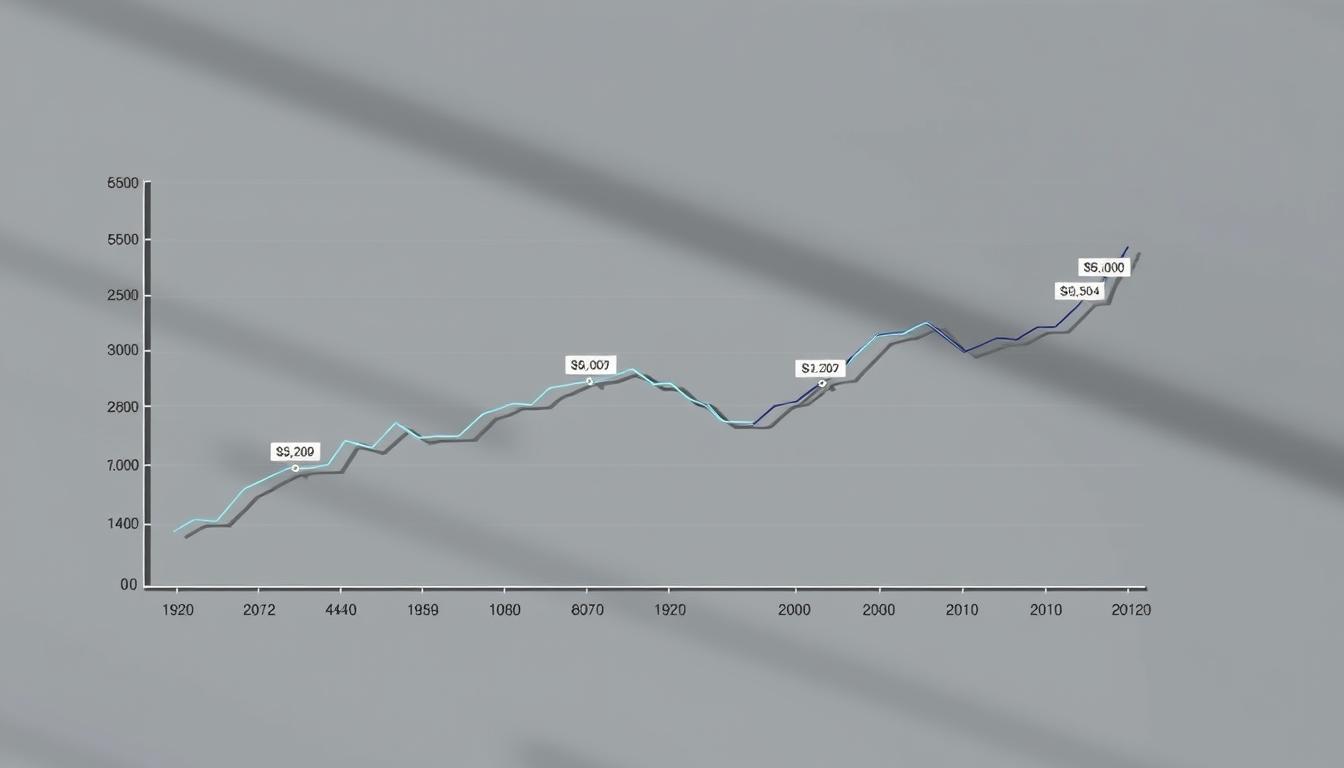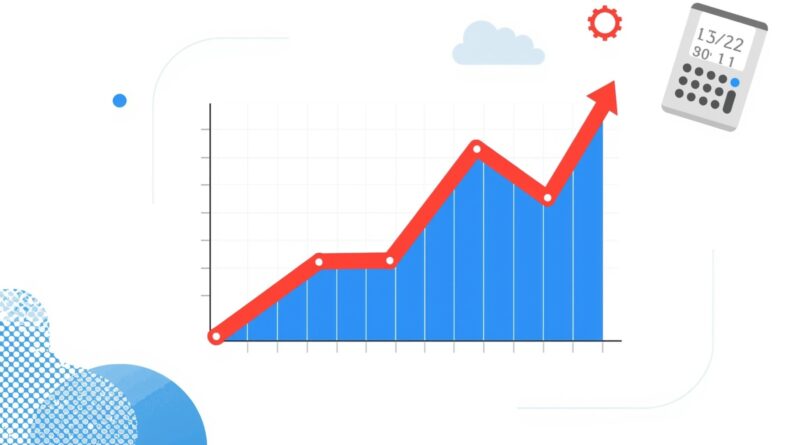10-Year Mortgage Interest Rate Outlook: What’s Ahead?
The future of mortgage interest rates is a big deal for homeowners and investors. Knowing what’s coming can guide our choices.

The economy and financial markets are always changing. To guess what mortgage interest rates will do next, we look at the economy and money policies.
This article will give you a peek at the 10-year outlook for mortgage rates. It’s here to help you understand what’s coming and get ready for it.
Current State of Mortgage Interest Rates
To understand mortgage interest rates, we need to look at recent trends. The mortgage market changes due to many factors. These include economic signs, global events, and shifts in financial markets.

Recent Trends in the Mortgage Market
Recently, mortgage rates have seen ups and downs because of economic uncertainty. Industry experts say the last year has seen big changes in mortgage rates. This is because of Federal Reserve actions and worries about inflation.
Because of this, borrowers have had to adjust. Some have chosen fixed-rate mortgages to keep their payments steady.
The housing market also affects interest rates. Supply and demand are key in this.
“The housing market continues to be a key driver of economic growth, with mortgage rates playing a pivotal role in homebuying decisions.”
Comparison to Historical Averages
Looking at current rates compared to the past gives us important context. Mortgage rates have changed a lot over time. In the 1980s, rates were high, and in the early 2000s, they were lower.
Now, rates are relatively low compared to before. This makes it a good time for people thinking about buying a home.
But, it’s important to remember that today’s rates are shaped by many things. These include global economic trends and monetary policy. Knowing about these is key for smart choices in the mortgage market.
Historical Context: Mortgage Rates Over the Past Decades
Knowing the history of mortgage rates helps us guess what will happen next. The mortgage market has changed a lot over the years. This change is due to many economic factors.
Key Rate Fluctuations Since 2000
Since 2000, mortgage rates have gone up and down a lot. In the early 2000s, rates went down, hitting a record low in 2008. Then, rates slowly went up until the COVID-19 pandemic made them drop again.
Key events influencing mortgage rates include:
- The 2008 financial crisis
- Quantitative easing by the Federal Reserve
- Economic impacts of the COVID-19 pandemic
Lessons from Previous Rate Cycles
Looking at past rate cycles teaches us a lot. For example, rates going up fast in the early 2000s slowed down the housing market. But, low rates in the 2010s made people want to buy homes more.

How Past Predictions Matched Reality
Looking at how past predictions did compared to real results shows how hard it is to guess mortgage rates. Things like inflation, GDP growth, and what the Federal Reserve does are very important.
| Year | Predicted Rate | Actual Rate |
|---|---|---|
| 2010 | 5.0% | 4.7% |
| 2015 | 4.5% | 3.8% |
| 2020 | 3.0% | 2.9% |
This history is key to understanding future mortgage rates and making smart housing market predictions.
Economic Indicators Driving Mortgage Rate Changes
Many economic indicators shape mortgage rates. Knowing these factors helps predict the housing market’s future.
Federal Reserve Policies and Their Impact
The Federal Reserve is key in setting mortgage rates. It changes the federal funds rate, affecting all interest rates. For example, lowering the federal funds rate makes mortgage rates drop, helping the housing market grow.
Inflation’s Role in Rate Determination
Inflation greatly affects mortgage rates. When inflation goes up, lenders raise rates to keep up. This is because money repaid later will be worth less. So, higher inflation means higher mortgage rates.

GDP Growth and Employment Factors
GDP growth and job rates are important for mortgage rates. A strong economy with low joblessness means higher rates. This is because a growing economy can cause inflation. On the other hand, a slow economy might see lower rates to boost growth.
Housing Supply and Demand Dynamics
The balance between housing supply and demand affects mortgage rates. High demand and low supply push prices up. This can make mortgage rates higher because more people need to borrow money.
| Economic Indicator | Impact on Mortgage Rates | Reason |
|---|---|---|
| Federal Reserve Policies | Direct Influence | Adjusts federal funds rate, influencing overall interest rates |
| Inflation | Increases Rates | Lenders raise rates to compensate for inflation |
| GDP Growth & Employment | Higher Rates in Strong Economy | Strong economy can lead to inflation |
| Housing Supply & Demand | Higher Demand = Higher Rates | Increased demand for housing and mortgage financing |
Mortgage Interest Rate Forecast for Next 10 Years
Knowing what mortgage interest rates will do in the next decade is key for both homebuyers and investors. The next ten years will be full of both promise and uncertainty. We’ll look at the forecast closely, keeping an eye on economic signs and trends that will shape the mortgage world.

Short-Term Projections (2023-2025)
In the short term, mortgage interest rates will likely change due to economic shifts. The Federal Reserve’s actions will greatly affect these rates. Experts predict a slow rise in rates by 2025, driven by inflation and economic growth.
Medium-Term Outlook (2026-2028)
Looking to the medium term, rates might level out. This phase will see a mix of economic growth and the Federal Reserve’s policies. The balance between housing supply and demand will also play a big role in rates during this time.
Long-Term Forecast (2029-2033)
In the long term, rates might drop a bit as the economy adjusts to past rate hikes. New tech in mortgage lending and global economic shifts will shape long-term rates.
| Period | Forecast | Influencing Factors |
|---|---|---|
| 2023-2025 | Gradual Increase | Inflation, Economic Growth |
| 2026-2028 | Stabilization | Monetary Policies, Housing Market |
| 2029-2033 | Slight Decrease | Technological Advancements, Global Trends |
Global Economic Factors Influencing U.S. Mortgage Rates
The world’s economies are connected, affecting U.S. mortgage trends. Knowing these connections helps predict interest rates.
International Market Interdependencies
The U.S. mortgage market is tied to global trends. Trade policies, exchange rates, and commodity prices shape U.S. mortgage rates. For example, changes in oil prices can influence inflation and interest rates.
Foreign Investment in U.S. Housing
Foreign investment in U.S. housing is key. International buyers, drawn by the U.S. economy’s stability, buy homes and securities. This boosts demand and can lower mortgage rates.
“The influx of foreign capital into the U.S. housing market has been a significant factor in keeping mortgage rates low, as it increases demand for mortgage-backed securities.” –
Global Economic Uncertainties
Uncertainties like geopolitical tensions and economic downturns affect U.S. mortgage rates. Investors seek safe assets like U.S. Treasury bonds, impacting mortgage rates.
| Global Economic Factor | Impact on U.S. Mortgage Rates |
|---|---|
| International Trade Policies | Influences inflation expectations and economic growth |
| Foreign Investment in U.S. Housing | Increases demand for mortgage-backed securities, lowering rates |
| Global Economic Uncertainties | Drives investors to safe-haven assets, affecting bond yields and mortgage rates |
Understanding global economic factors is crucial for predicting mortgage trends. It helps make informed decisions in the U.S. housing market.
Expert Opinions on Future Mortgage Trends
The mortgage world is always changing, and expert views are key to understanding these changes. People like banking experts, real estate economists, government agencies, and independent analysts share their thoughts on mortgage rates. They help us see where mortgage rates might go.
Banking Sector Predictions
Banking experts are hopeful about mortgage rates. A survey found that 70% of banking pros think rates will calm down soon. They point to monetary policy changes and economic signs as important factors.
Real Estate Economist Perspectives
Real estate experts look at the housing market’s balance. They say places with high demand and little supply will see higher rates. They also talk about population growth and urban trends as big influences.
Government Housing Agency Forecasts
Government agencies predict a slow rise in mortgage rates over ten years. They say this will happen as the economy gets better and prices adjust. They stress the need for affordable housing plans to help buyers.
Independent Analyst Viewpoints
Independent analysts warn about global economic ups and downs affecting U.S. rates. They think these changes could make rates unpredictable. So, it’s crucial for buyers and investors to keep up with these changes.
Looking at all these expert views helps us understand the mortgage future better. It helps us make smarter choices.
Different Mortgage Types and Their Projected Rates
Looking ahead, it’s key to see how forecasted mortgage rates will affect different types. The mortgage world is complex. It has many products, each with its own benefits and challenges.
Fixed-Rate Mortgages Outlook
Fixed-rate mortgages are loved for their stability. They have a fixed interest rate, so monthly payments stay the same. Experts predict these rates will stay steady, with a bit of increase as the economy grows.
Adjustable-Rate Mortgages Forecast
Adjustable-rate mortgages (ARMs) offer flexibility. Their interest rates can change over time, based on the market. The forecast says ARMs might be more appealing, with lower initial rates. But, there’s a chance rates could go up later.
Jumbo Loan Projections
Jumbo loans are for pricier homes. Their rates are expected to swing with the economy and housing trends. Borrowers should get ready for possibly higher rates and stricter rules.
FHA and VA Loan Rate Trends
FHA and VA loans are backed by the government. They offer good deals for certain borrowers. Rates for these loans are expected to mirror the market, with small changes due to government actions and insurance costs.
Knowing these trends can help borrowers make smart choices. Whether buying a new home or refinancing, understanding these rates is crucial.
Strategies for Navigating Future Rate Environments
Looking ahead, knowing how to handle mortgage rates is key. The 10-year mortgage rate forecast shows changes are coming. This is important for those buying homes, investing, or looking to refinance.
First-Time Homebuyer Considerations
First-time buyers need to get the long-term mortgage trends. They should think about how rates might change over time. It’s smart to look at different loan types to find the best fit for their budget.
Investment Property Strategies
Investors should think about rental income and how rates might affect it. With the 10-year mortgage rate forecast showing possible hikes, they might choose shorter loans or other financing options to reduce risk.
Refinancing Opportunities Timeline
Homeowners should watch long-term mortgage trends for refinancing chances. A good timing can help them get lower rates. Here’s a table showing when refinancing might be a good idea based on forecasted rates.
| Year | Forecasted Rate | Refinancing Opportunity |
|---|---|---|
| 2025 | 4.5% | High |
| 2027 | 5.0% | Moderate |
| 2030 | 4.0% | High |
Technological Changes in Mortgage Lending
The mortgage world is changing fast, thanks to technology. Online tools make applying for mortgages and managing accounts easier. Keeping up with these long-term mortgage trends helps borrowers make better choices.
In summary, dealing with future rate changes needs a smart plan. By understanding the 10-year mortgage rate forecast and long-term mortgage trends, everyone can make better mortgage decisions.
Potential Risks and Uncertainties in Rate Projections
It’s important to know the risks and uncertainties in interest rate projections. This knowledge helps us navigate the future of mortgage rates. Several factors could change the path of mortgage rates, so it’s key to consider these.
Economic Recession Scenarios
Economic recessions can greatly affect mortgage rates. When the economy slows down, people might want to buy fewer homes. This could make mortgage rates go down as lenders try to boost the market. Yet, recessions can also make it harder to get a mortgage because of stricter lending rules.
Regulatory Policy Changes
Changes in rules can also impact mortgage rates. For example, rules that make housing more affordable might lower mortgage rates. But rules aimed at reducing risk could raise rates. Keeping up with these changes is vital.
Demographic Shifts Affecting Housing Demand
Changes in the population can also change housing demand and mortgage rates. For instance, an older population might have different housing needs. This could affect the types of mortgages people want.
In summary, the future of mortgage rates is full of risks and uncertainties. By understanding these, including economic downturns, rule changes, and demographic shifts, we can prepare for the mortgage landscape ahead.
Conclusion: Navigating the Future of Mortgage Rates
Looking ahead, knowing how mortgage interest rates will change is key. Our study shows how economic signs, global events, and expert views will affect rates. This knowledge is vital for smart choices in the housing market.
Experts predict rates will be shaped by the Federal Reserve, inflation, and economic growth. Homebuyers and investors need to keep up with the latest rate outlook. They must also be ready to adjust their plans as needed.
Understanding mortgage rates’ history and current trends helps make better choices. Whether you’re buying your first home or investing, staying updated is crucial. It’s essential for reaching your goals in the changing housing market.
FAQ
What are the key factors influencing mortgage interest rates over the next 10 years?
Mortgage interest rates are influenced by several factors. These include Federal Reserve policies and inflation rates. GDP growth, employment rates, and housing supply and demand also play a role.
How do global economic factors impact U.S. mortgage rates?
Global factors like international market interdependencies affect U.S. mortgage rates. Foreign investment in U.S. housing and global economic uncertainties also have an impact.
What is the outlook for fixed-rate mortgages over the next decade?
The outlook for fixed-rate mortgages depends on long-term interest rate projections. Economic indicators also influence these rates, leading to fluctuations based on market conditions.
How will adjustable-rate mortgages be affected by future rate changes?
Adjustable-rate mortgages will see direct impacts from interest rate changes. Rates may increase or decrease based on market conditions.
What are the projected rates for jumbo loans over the next 10 years?
Jumbo loan rates are expected to follow the trend of other mortgage rates. They will be influenced by economic indicators and market conditions.
How will FHA and VA loan rates be affected by future economic trends?
FHA and VA loan rates will be influenced by government policies and economic indicators. Rates may change over the next decade.
What strategies can first-time homebuyers use to navigate future rate environments?
First-time homebuyers can lock in rates and explore different mortgage options. Staying informed about market trends is also key to navigating future rate environments.
How can investment property owners prepare for potential rate changes?
Investment property owners can consider refinancing opportunities. They can also adjust their investment strategies and stay updated on market trends to prepare for rate changes.
What are the potential risks and uncertainties in mortgage rate projections?
Risks and uncertainties include economic recession scenarios and regulatory policy changes. Demographic shifts affecting housing demand are also factors to consider.
How will technological changes in mortgage lending impact the industry?
Technological changes in mortgage lending are expected to improve efficiency and reduce costs. They will also enhance the borrower experience.

